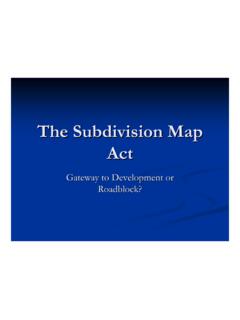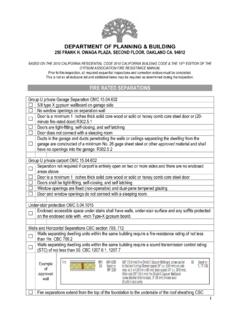Transcription of ASHRAE Standard 62.1-2010 Ventilation for Acceptable ...
1 ASHRAE Standard Ventilation for Acceptable Indoor Air Quality Presented by Roger Hedrick, LEED AP, BEMP Chair, SSPC ASHRAE Standard Overview General comments General requirements Ventilation requirements Construction and O/M requirements Energy Efficiency Options Possible Coming Changes Questions ASHRAE Standard What s Its History? 62-2001 Prescriptive Commissioning O&M Combustion air Filtration 62-1999 IAQ-Health disclaimers Smoking disclaimers Clarified CO2as Ventilation metric 62-1989 Removed Thermal Comfort Ventilation Rate Proc. IAQ Proc.
2 62-1973 first issued 62-1981 Alternative Air Quality Proc. 1990 2000 2010 1970 1980 Commercial and High Rise Res. Enforceable code language ETS vent. rates not covered Vent. Rate. Proc. Modified Occupant and area vent. rates Updated 1. Purpose Specify minimum Ventilation rates and other measures intended to provide IAQ that is Acceptable to human occupants and that minimizes adverse health effects Intended for regulatory application to new buildings and additions Guide the improvement of IAQ in existing buildings 2. Scope All spaces intended for human occupancy excluding low-rise residential ( ) Defines requirements for Ventilation , air-cleaning design, commissioning, installation and O&M Additional requirements and other standards may apply (labs, healthcare, industrial, etc.)
3 May be applied to both new and existing buildings, not intended to be used retroactively Does not prescribe specific Ventilation rates for smoking spaces 2. Scope Ventilation requirements based on chemical, physical, & biological contaminants Consideration or control of thermal comfort is not included In addition to Ventilation , the Standard contains requirements related to certain sources 2. Scope Acceptable IAQ may not be achieved in all buildings meeting these requirements because of: Diversity of sources and contaminants Air temperature, humidity, noise, lighting, and psychological/social factors Varied susceptibility in the occupants Introduction of outdoor contaminants 3.
4 Definitions 36 Terms Defined Two of Particular Significance Acceptable Indoor Air Quality Occupiable Space General Requirements 4. Outdoor Air Quality Regional Air Quality Must determine NAAQS attainment status Air cleaning is required in some cases in non-attainment areas Local Air Quality Conduct observational site survey to identify local sources of air contaminants General Requirements 4. Outdoor Air Quality Documentation Regional air quality compliance status Local survey information Conclusions regarding acceptability of outdoor air quality General Requirements 5.
5 Systems and Equipment Ventilation Air Distribution Must provide means to adjust the system Minimum Ventilation air must be provided to each terminal unit in ceiling/floor plenum systems General Requirements 5. Systems and Equipment Exhaust Duct Location Operate exhaust ducts with harmful contaminants at negative pressure Ventilation System Controls Control to assure proper Ventilation under any operating condition Airstream Surfaces Use materials that have documented resistance to microbial growth and erosion General Requirements 5. Systems and Equipment Outdoor Air Intakes Separate OA intake from outdoor contaminant sources Must comply with default minimum separation distances in Table 5-1.
6 Examples: Loading dock 25 ft Dumpster 15 ft Surface below intake 1 ft cooling tower exhaust 25 ft Must limit moisture penetration (using hood, proper velocity, etc.) or manage water that penetrates Prevent moisture intrusion into equipment mounted outdoors Must use bird screens and prevent bird nesting General Requirements 5. Systems and Equipment Local Capture of Contaminants Discharge air from non-combustion equipment that captures contaminants shall be exhausted to the outdoors Combustion Air Follow manufacturer s instructions to provide sufficient combustion air and exhaust air for indoor fuel-fired appliances Products of combustion from vented appliances shall be vented directly outdoors General Requirements 5.
7 Systems and Equipment Particulate Matter Removal Use a filter rated at MERV 6 (or greater) upstream of cooling coils and other wet-surface devices in supply stream General Requirements 5. Systems and Equipment Dehumidification Systems Must be able to limit indoor RH to 65% or less at design dew point condition Exception to RH limit - where occupancy requirements or processes dictate higher RH conditions Intake airflow must be greater than relief/exhaust during cooling (to minimize moist air infiltration) 62 F DP 65% RH limit General Requirements Dehumidification Systems General Requirements 5.
8 Systems and Equipment Drain Pans Assure drainage without flooding or carryover Slope: (1/8 ) per foot toward outlet Drain: located at lowest point, with sufficient diameter prevent overflow Drain seal: Shall include P-trap or other seal for negatively pressurized drain pans to prevent ingestion of air while allowing complete drainage (fan on or off) Pan size: length at least 1/2 coil height or as necessary to limit carryover General Requirements 5. Systems and Equipment Finned Tube coils and Heat Exchangers Provide drain pan beneath all dehumidifying cooling coil assemblies and all condensate producing heat exchangers Select to limit coil pressure drop to @ 500 fpm face velocity Exception- higher pressure drop can be accommodated by providing access on both sides and providing clear and complete instructions for maintenance General Requirements 5.
9 Systems and Equipment Humidifiers and Water Spray Systems Use potable water (or better) No downstream devices within absorption distance Exception- devices or obstructions provided with appropriate drain pan General Requirements 5. Systems and Equipment Access for Inspection, Cleaning and Maintenance. Install equipment with sufficient working space for access and maintenance Provide access doors, panels or other means to allow convenient and unobstructed access for maintenance of the HVAC system General Requirements 5. Systems and Equipment Building Envelope and Interior Surfaces Weather barrier to prevent water penetration into envelope Vapor retarder or other means to prevent condensation on cold surfaces within envelope Seal all exterior seams, joints, penetrations to limit infiltration Insulate pipes and ducts expected to have surface temperature below surrounding dew point General Requirements 5.
10 Systems and Equipment Buildings with Attached Parking Garages. Limit infiltration of vehicular exhaust: Maintain garage pressure at or below adjacent occupied space Or, use a vestibule Or, otherwise design to minimize air migration from garage to occupied space General Requirements 5. Systems and Equipment Air Classification and Recirculation. Designate expected air quality classification for all return transfer or exhaust air (refer to table , and for examples of air classes) Class 1: Low contaminant concentration Class 2: Moderate concentration Class 3: Significant concentration Class 4: Highly objectionable or potentially harmful concentration General Requirements 5.






